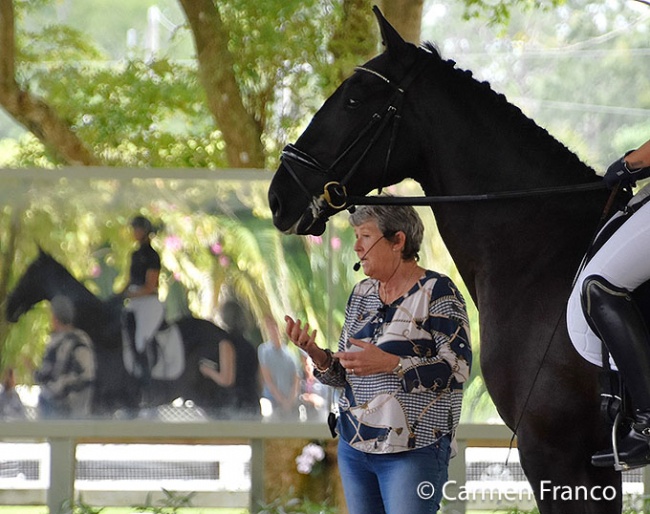
This article by Carmen Franco is a continuation of 2023 U.S. Lusitano Conference - Pedro Torres: "Teach Your Horse the Code"
2023 U.S. Lusitano Conference - Kyra Kyrklund:
When I heard the US Lusitano Association was planning to host Kyra Kyrklund in their inaugural Lusitano Conference at May Faire Oaks farm, my work home, I set my mind to prepare Emir (also known as "BP" as in Black Pearl) to ride with her. I have had the honour and privilege to ride in two symposiums with her before, coincidentally with Lusitanos too, and I learned so much, so it needed to happen again!
It’s been several years since Kyra and her husband Richard (equally genius) have been to Florida and our excitement to welcome them back was high. My submission to be preselected as rider was accepted (thank you, team!) and we had to show the horses on Tuesday to pick the final selection and see what they could work on in front of the public. All of us were asked if we didn’t want to show some movements, which I thought was very respectful of our processes and horses. As Kyra later said, “riding is difficult” and even more in front of public that sometimes is so easy to jump into criticism. And don’t even let me get started with the online gurus… thankfully, the clinic had a policy of no videos/pictures and most attendees complied.
Riding BP in the Masterclass meant that I couldn’t pay much attention to the combinations before and after my turn. But I will do a brief description of them as I found out (through Kyra and some of my friends attending) what they worked on.
Steady Connection
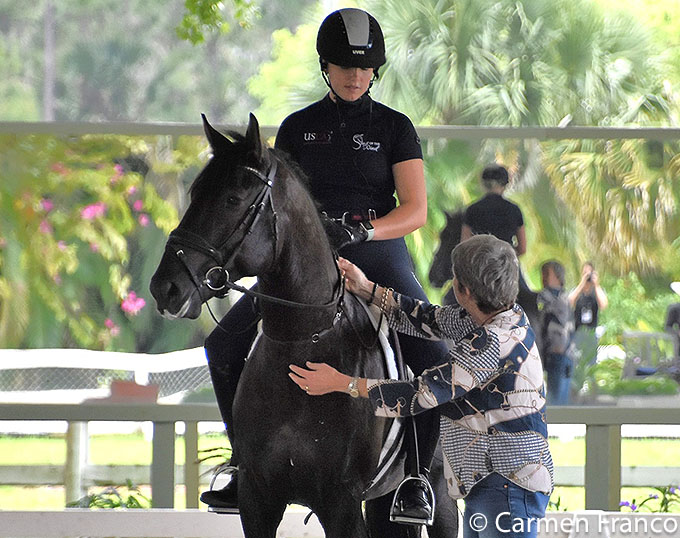
She is on Oregon de Castanheiro
(by Diamante N x Paragrafo TOP)
They worked mainly on establishing a steadier connection and used a rope around the neck to help the rider and the horse to find better balance. “You have to take connection to get contact, even if it gets heavy or deep for a while”. The rope “stimulates” the use of the chest/lower neck muscles to not drop, therefore helps with putting the horse more together and helps with the idea of going more uphill. At the same time, it helps the rider to find a better place for the hands and the body, creating a better influence on the horse. “The topline should be longer, the underline should be shorter”.
Repetitions to Make and Break a Habit
I had told Kyra that one of the movements I have struggled to correct on BP were the flying changes. I have 4s, 3s, 2s and some ones but they really sway right and left from the line I do them.
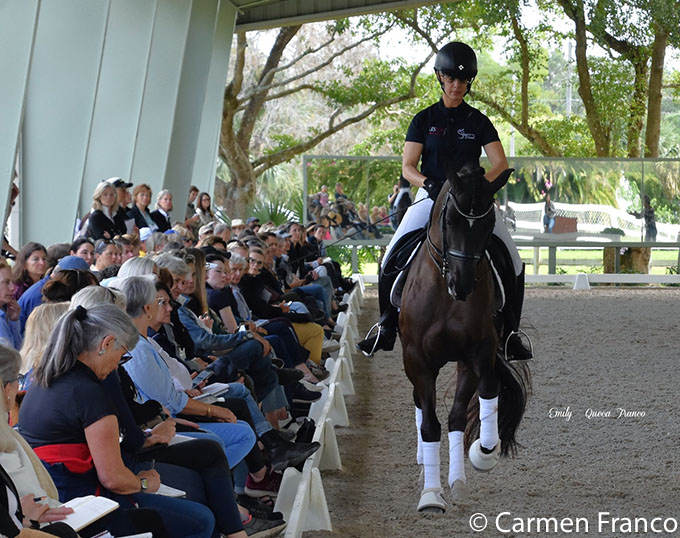
To my own joy, I saw him go straighter to it and I was able to perform a few with the new outside aids, that were quite straight. Of course, this lasted until I lost concentration… to what Kyra reminded us how difficult it is to change patterns and how much it takes to memorize movement in our brain and body. ¨It takes 100,000 repetitions to make it a habit and an additional 5,000 to break a habit."
A Long Leg that Only Tickles the Horse
Oz was the youngest of the horses presented. Kyra helped Maggie find a steadier position in the saddle with a loose, long leg that only tickles the horse, doesn’t squeeze it. With a relaxed leg, the hip finds a better place in the saddle and that gives more stability to the upper body. The arms hang down, the elbows bend and the wrists are soft. The young horse follows the rider’s reins for steering first, that’s why it is so important to be steady.

x Xirineus Paixiao)
Another point they went through was how Maggie could manage her body during the posting trot. She was asked to hold two strides up and go softly down one. Also post quicker or slower to influence the speed of the horse. Oz showed some beautiful strides!
Kyra advised to use the whip behind the leg of the rider, not on the hindleg of the horse. That way, he learns to pay attention to the leg aid. “Don’t push every stride, sit still, use leg once”. If you need the help of the whip, keep it on the outside in the canter. The outside leg just needs to be 5 centimeters behind, not too far back. When the rider is more balanced in the saddle, it can help the horse turn with the weight. Horse needs to be ridden like going through a tunnel, with the stability of the rider’s aids.
Contol the Position of the Neck

They worked on leg-yielding asking the horse to cross clearly over, but not get faster. To help the rider control the horse from running away and work on improving bend on the hindlegs, Kyra suggested to go back to turn on the forehand, movement a bit forgotten in the repertoire of many riders. During the turn, the rider can play with flexion and counter flexion.
They worked leg-yielding at the trot and canter too, where Kyra asked Jennifer to make bigger and smaller, quicker, and slower strides sideways. Also changing the flexion into bend to convert the leg-yield into a half-pass. “For a half-pass to be good, horse needs to accept the outside leg of the rider”.
They worked also on canter collection on a small circle where Kyra asked Jennifer to pat the horse with the outside hand. “The rider needs to be able to put the neck of the horse up or down when they want to”. If riding with the double bridle, the rider needs to understand that the bradoon will work on keeping the horse’s head/neck up and the curb down. The rider must know how to work in between both.
Establishing Better Collection
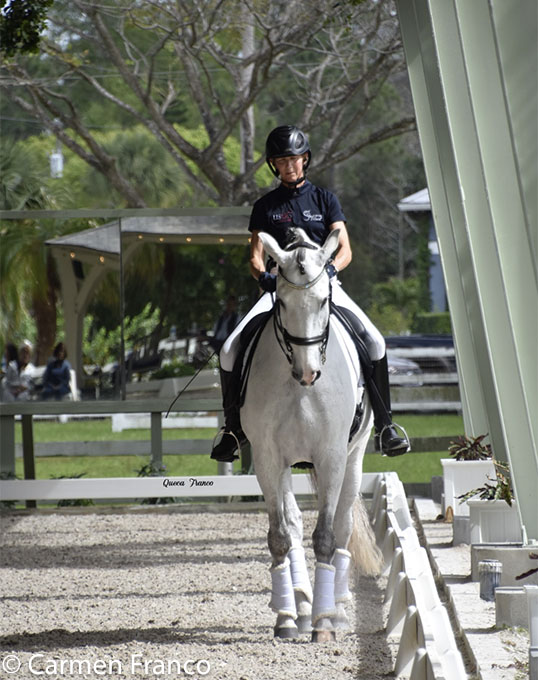
It was good to see the effect of keeping the walk and the canter short, then introducing a pirouette at the walk, to convert it into a canter pirouette. Kyra said: “pat him with your outside hand”, asking Nancy to stay more on her inside rein and use the outside only if the horse wanted to run away. If the canter felt a bit up and down (or rocking), she suggested to lower the neck without letting the shoulders go down. “You should never work harder in pirouettes than you would to ask for a canter transition”. If you are riding a complicated movement like pirouettes, don't spend time doing bad ones, break them down to the individual components and improve them. The better the engagement, the better the coming up in front will be. Pirouette and piaffe have the same outline, if the horse does one good, most probably the other one will be good too.
At the end of this session, Kyra stressed to check for improvement in every single movement we have in a test, if we do all of them 0.5 better in score, we will get a much better percentage at the end.
Quiet Hands and Legs
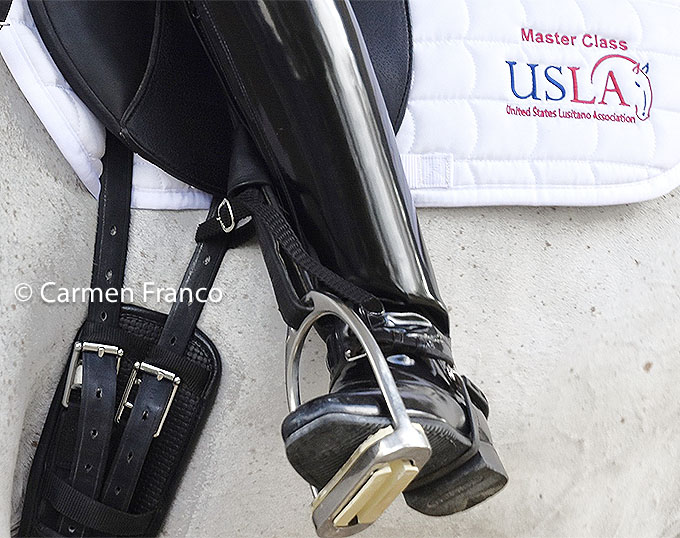
Since Gigi has a very powerful hindleg, Kyra asked Kyle to control her body in the rising trot by posting slower than the mare’s rhythm. Also, to go up, stay in light sit for a few strides until finding a cadence. Then they worked on sitting one stride and go up two, when sitting again, doing it softly so the back of the horse can stay up. The strap in the saddle helped Kyle maintain her hands lower. “The higher the hand, the lower the horse will go”.
When Gigi kept trying to do big strides with the hindlegs, Kyra asked Kyle to push her to the side but focusing on maintaining the body straight in alignment. They went into working turn on the forehand as the front end can’t run away in this movement. While on it, rider must touch the inside hindleg (when going up) with a whip to help it bend more. From there, the piaffe can be developed.
Flexion and Straightness
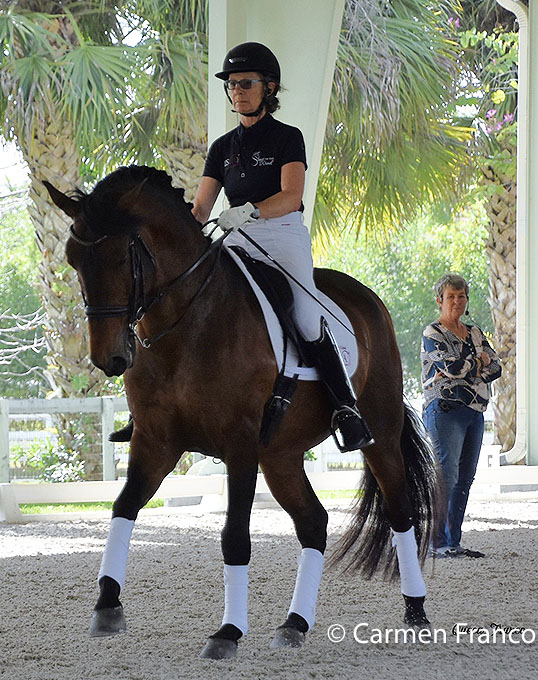
Wembley)
Then they worked on preparation for the zig-zag. At the walk, Candy had to take the centerline and move the hindlegs to the right or to the left while maintaining Enrique’s shoulders and head straight. After achieving more suppleness both ways, they started the following exercises: canter right, push with the left leg the hindlegs to the right, make the horse straight, then flying change, then push the hindlegs to the left and so on. They also did a sharp half-pass to the centerline and then renvers, followed by making the horse straight, then ask for a flying change and start the next half-pass. “Be sure you can flex, counter-flex and make your horse straight”. After a little break, they did 3 strides sideways, 3 strides straight, and Kyra suggested that, even in a long half-pass, you can count every x number of strides to change the flexion. “Give your aids in rhythm, let the horse know”.
Body Control
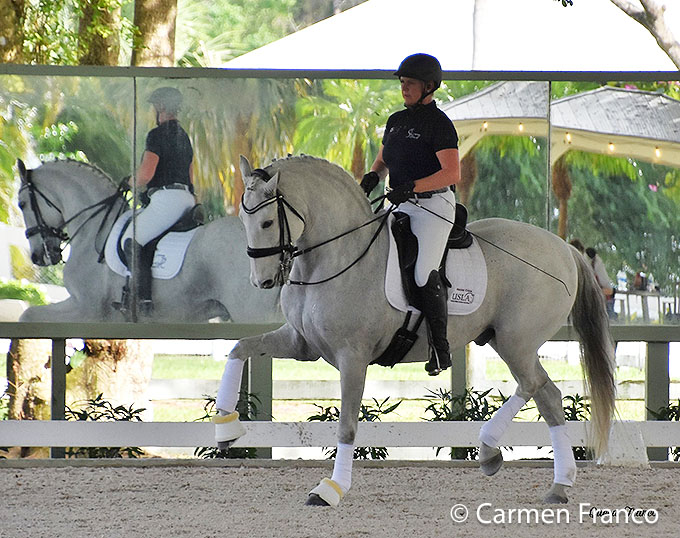
We were able to learn also some very helpful tips to improve the piaffe and passage, like using turn on the forehand at the piaffe with a small flexion to the outside and produce very small steps to improve engagement. For the passage Tyra was asked to do rising trot, go slower, push the hindlegs out, then make the horse straight, find short steps. “If you lose the hindleg, push them out”.
Kyra used this explanation: if you want to bounce a beach ball, you variate how quick your hand meets the ball, but your hand needs to be flexible for the ball to bounce. Same happens with the back of the horse: the rider needs to know how to maintain control of his own energy to move up and down. “Your weight is the one thing that's influencing the horse all the time”.
While stressing that the rider needs to be patient training horses, she also said “Don't go on and on practicing a movement, at some point in a dressage test it has to happen the first time you ask”.
Inspiring
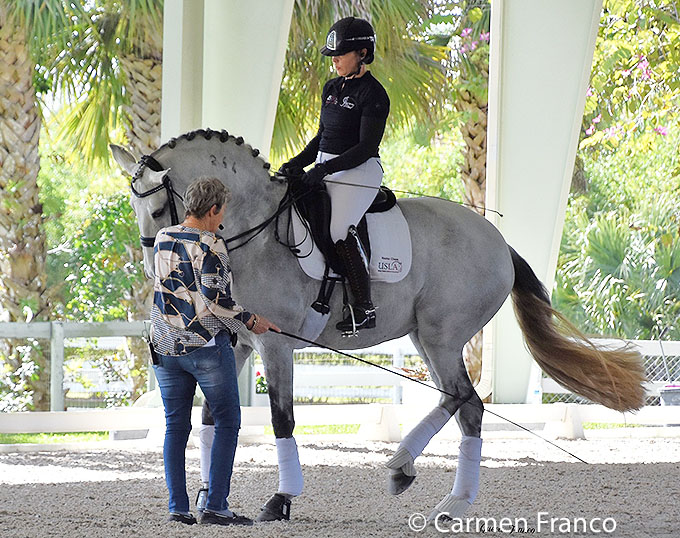
Turn on the forehand helping hindleg to bend and
engage without running away.
A huge thank you goes out to the US Lusitano Association for organizing this fantastic event, to May Faire Oaks farm for hosting, to the riders/horses and their teams, to the sponsors and volunteers. The bar was set really high!
Text and Photos © Carmen Franco
Related Link
2023 U.S. Lusitano Conference - Pedro Torres: "Teach Your Horse the Code"